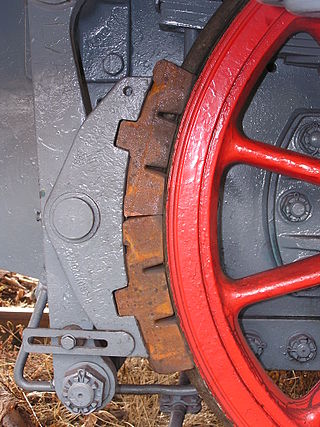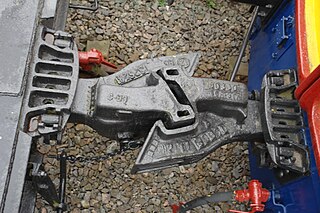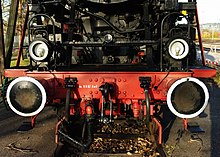The Armagh rail disaster happened on 12 June 1889 near Armagh, County Armagh, in Ireland, when a crowded Sunday school excursion train had to negotiate a steep incline; the steam locomotive was unable to complete the climb and the train stalled. The train crew decided to divide the train and take forward the front portion, leaving the rear portion on the running line. The rear portion was inadequately braked and ran back down the gradient, colliding with a following train.

Brake van and guard's van are terms used mainly in the UK, Ireland, Australia and India for a railway vehicle equipped with a hand brake which can be applied by the guard. The equivalent North American term is caboose, but a British brake van and a caboose are very different in appearance, because the former usually has only four wheels, while the latter usually has bogies. German railways employed brakeman's cabins combined into other cars.

Multiple-unit train control, sometimes abbreviated to multiple-unit or MU, is a method of simultaneously controlling all the traction equipment in a train from a single location—whether it is a multiple unit comprising a number of self-powered passenger cars or a set of locomotives—with only a control signal transmitted to each unit. This contrasts with arrangements where electric motors in different units are connected directly to the power supply switched by a single control mechanism, thus requiring the full traction power to be transmitted through the train.
Rail transport terms are a form of technical terminology applied to railways. Although many terms are uniform across different nations and companies, they are by no means universal, with differences often originating from parallel development of rail transport systems in different parts of the world, and in the national origins of the engineers and managers who built the inaugural rail infrastructure. An example is the term railroad, used in North America, and railway, generally used in English-speaking countries outside North America and by the International Union of Railways. In English-speaking countries outside the United Kingdom, a mixture of US and UK terms may exist.

The British Rail Class 73 is a British electro-diesel locomotive. This type is unusual in that it can operate on the Southern Region's 650 / 750 V DC third rail power supply, or an onboard diesel engine to allow it to be used on non-electrified routes. This makes it very versatile, although the diesel engine produces less power than is available from the third-rail power supply, so the locomotives are rarely used outside of the former Southern Region of British Rail. It is one of the first bi-mode locomotives ever built. Following the withdrawal and scrapping of the more powerful Class 74 bi-mode locomotives in 1977, the Class 73 was unique on the British railway network until the introduction of the Class 88 bi-mode locomotives in 2017. Ten locomotives have been scrapped.

Main components found on a typical steam locomotive include:

The British Rail Class 85 is an electric locomotive that was designed and produced at British Rail’s (BR) Doncaster Works during the early 1960s. While largely developed by BR, much of its systems can be attributed to the British manufacturing interest Associated Electrical Industries (AEI).

A coupling or coupler is a mechanism, typically located at each end of a rail vehicle, that connects them together to form a train. The equipment that connects the couplers to the vehicles is the draft gear or draw gear, which must absorb the stresses of the coupling and the acceleration of the train.

A railway brake is a type of brake used on the cars of railway trains to enable deceleration, control acceleration (downhill) or to keep them immobile when parked. While the basic principle is similar to that on road vehicle usage, operational features are more complex because of the need to control multiple linked carriages and to be effective on vehicles left without a prime mover. Clasp brakes are one type of brakes historically used on trains.

A buffer is a part of the buffers and chain coupler system used on the railway systems of many countries, among them most of those in Europe, for attaching railway vehicles together.
This article contains a list of jargon used to varying degrees by railfans, trainspotters, and railway employees in the United Kingdom, including nicknames for various locomotives and multiple units. Although not exhaustive, many of the entries in this list appear from time to time in specialist, rail-related publications. There may be significant regional variation in usage.
Type H Tightlock couplers are a variety of Janney coupler, typically used on North American mainline passenger rail cars. They have mechanical features that reduce slack in normal operation and prevent telescoping in derailments, yet remain compatible with other Janney types used by North American freight railroads.

SA3 couplers or Willison coupler and Russian coupler are railway couplings used primarily in Russia and states influenced by the former Soviet Union, such as Finland, Poland, and Mongolia.
The rolling stock used on the Isle of Man Railway today is entirely original although, from an original total of 75 carriages, the number serviceable dropped as low as 14, but this total is once again increasing as a result of recent rebuilds The 3 ft gauge railway was provided with a variety of stock from different manufacturers over its time, and types of coach were categorised according to a lettering system, with the original four-wheeled coaches being of A, B, C and D types, and so on. The F prefix encompassed all bogie vehicles including conversions from the A-D series. Letters G-M denoted goods stock. N referred to ex-Manx Northern Railway 6 wheel carriages. The types of stock can be summarised as follows:-
Electronically controlled pneumatic brakes are a type of railway braking systems.
Janney couplers are a semi-automatic form of railway coupling that allow rail cars and locomotives to be securely linked together without rail workers having to get between the vehicles. They are also known as American, AAR, APT, ARA, MCB, knuckle, Buckeye, tightlock or Centre Buffer Couplers.

A Norwegian coupling or coupler, is a manually operated coupling at each end of some narrow-gauge railway rolling stock. It consists of a central buffer incorporating a hook that drops into a slot in the opposing central buffer. The system is only found on narrow gauge railways with a gauge of 1067 mm or less on which low speeds and train loads allow a simpler system than, for example, knuckle couplers. Norwegian couplings are not particularly strong, and may be supplemented by auxiliary chains. Not all Norwegian couplings are compatible with one another since they vary in height and width. Some may permit a hook from both rail vehicles to be in place; others may be limited to one.
From time to time, a railway decides that it needs to upgrade its coupling system from one that is proving unsatisfactory, to another that meets future requirements. This can be done gradually, which can create many problems with transitional incompatibilities, or overnight, which requires much planning.
Buffers and chain couplers are the de facto International Union of Railways (UIC) standard railway coupling used in the EU and UK, and on some railways in other parts of the world, such as in South America and India, on older rolling stock. Buffers and chain couplers are an assembly of several devices: buffers, hooks and links, or turnbuckle screws.

Different types of railroad rolling stock have different couplers depending on the purpose and type of equipment being used and its intended destination. European rolling stock tend to use buffers and chain couplers while American rolling stock uses a Janney coupler or "knuckle coupler". These are incompatible with each other, but where some railroads have obtained older, less expensive used rolling stock from different countries or regions, instead of having to standardize on one form of coupler, it may be useful to be able to use either type of coupler on a piece of rolling stock without having to remove anything.











